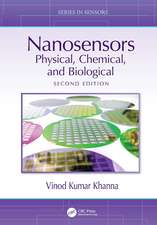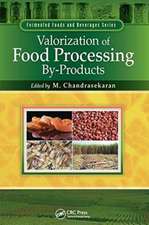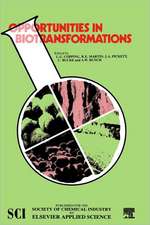Inorganic Membranes Synthesis, Characteristics and Applications: Synthesis, characteristics, and applications
Autor R. Bhaveen Limba Engleză Paperback – 14 feb 2012
Preț: 389.49 lei
Nou
Puncte Express: 584
Preț estimativ în valută:
74.53€ • 78.02$ • 61.67£
74.53€ • 78.02$ • 61.67£
Carte tipărită la comandă
Livrare economică 05-19 aprilie
Preluare comenzi: 021 569.72.76
Specificații
ISBN-13: 9789401165495
ISBN-10: 9401165491
Pagini: 336
Ilustrații: 336 p.
Dimensiuni: 152 x 229 x 18 mm
Greutate: 0.45 kg
Ediția:1991
Editura: SPRINGER NETHERLANDS
Colecția Springer
Locul publicării:Dordrecht, Netherlands
ISBN-10: 9401165491
Pagini: 336
Ilustrații: 336 p.
Dimensiuni: 152 x 229 x 18 mm
Greutate: 0.45 kg
Ediția:1991
Editura: SPRINGER NETHERLANDS
Colecția Springer
Locul publicării:Dordrecht, Netherlands
Public țintă
ResearchCuprins
1. The Developing Use of Inorganic Membranes: A Historical Perspective.- 1.1. Introduction.- 1.2. The Nuclear Period.- 1.3. The Development of Ultrafiltration and Microfiltration Inorganic Membranes: The 1980-1990 Period.- 1.4. The Third Stage in the Development of Inorganic Membranes: Further Developments by Other Organizations.- 1.5. Conclusions.- References.- 2. Synthesis of Inorganic Membranes.- 2.1. Introduction and Overview.- 2.2. Basic Principles of Membrane Synthesis.- 2.3. Packing of Particles from Suspensions.- 2.4. Typical Results for Different Materials.- 2.5. Phase Separation Leaching Methods and Glass Membranes.- 2.6. Anodic Oxidation.- 2.7. Pyrolysis.- 2.8. Track-Etch Method.- 2.9. Composite Membranes: Modification Methods.- 2.10. Miscellaneous Methods and Comments.- References.- 3. General Characteristics of Inorganic Membranes.- 3.1. Introduction.- 3.2. Commercial Inorganic Membranes.- 3.3. Microstructural Characteristics.- 3.4. Materials Properties.- 3.5. Membrane Element and Module Configurations.- 3.6. End-seal and Module Packing Materials.- References.- 4. Permeation and Separation Characteristics of Inorganic Membranes in Liquid Phase Applications.- 4.1. Introduction.- 4.2. Common Terminology and Definitions.- 4.3. Phenomena Influencing Flux and Separation During the Filtration Process.- 4.4. Microfiltration.- 4.5. Ultrafiltration.- 4.6. Liquid Permeation and Separation with Formed-in-Place (Dynamic) Membranes.- 4.7. Dense Membranes.- Nomenclature.- References.- 5. Liquid Filtration and Separation with Inorganic Membranes: Operating Considerations and some Aspects of System Design.- 5.1. Introduction.- 5.2. Cross-flow Membrane Filtration.- 5.3. The Effect of Operating Parameters on Membrane Filtration and Separation Performance.- 5.4. Backflushing:Theoretical Aspects.- 5.5. Membrane Regeneration.- 5.6. Microfiltration with Uniform Transmembrane Pressure.- 5.7. Operating Configurations.- 5.8. Some Aspects of System Design and Operation.- Nomenclature.- References.- 6. Gas Separations with Inorganic Membranes.- 6.1. Introduction.- 6.2. Porous Membranes.- 6.3. Dense Membranes.- 6.4. New Developments.- 6.5. Conclusions.- Nomenclature.- References.- 7. Inorganic Membrane Reactors to Enhance the Productivity of Chemical Processes.- 7.1. Inorganic Membranes for High-Temperature Applications.- 7.2. Gas (or Vapor) Phase Reactions: The Concept of the Membrane Reactor.- 7.3. Fundamental Aspects of Membrane Reactors.- 7.4. Assessment of Commercial Possibilities.- References.- 8. Inorganic Membranes in Food and Biotechnology Applications.- 8.1. Introduction.- 8.2. Applications of Inorganic Membranes in the Dairy Industry.- 8.3. Inorganic Membranes in the Clarification of Fruit Juices.- 8.4. Applications of Inorganic Membranes to Concentrate Proteinsin Food Industry.- 8.5. Clarification of Fermented Alcoholic BeveragesUsing Inorganic Membranes.- 8.6. Inorganic Membranes in Biotechnology Applications.- References.- 9. Inorganic Membranes for the Filtration of Water, Wastewater Treatment and Process Industry Filtration Applications.- 9.1. Introduction.- 9.2. Filtration of Water Using Inorganic Membranes.- 9.3. Non-oily Wastewater Treatment With Inorganic Membranes.- 9.4. Oily Wastewater Treatment with Inorganic Membranes.- 9.5. Inorganic Membranes in Process Industry Filtrations.- References.
Recenzii
This book of Bhave's fills the gap in today's literature on synthetic membranes and their application. In nine chapters, the most relevant aspects of inorganic membranes are comprehensively covered. - Chemical Engineering and Processing; This book of Bhave's fills the gap in today's literature on synthetic membranes and their application. In nine chapters, the most relevant aspects of inorganic membranes are comprehensively covered. - Chemical Engineering and Processing; This book of Bhave's fills the gap in today's literature on synthetic membranes and their application. In nine chapters, the most relevant aspects of inorganic membranes are comprehensively covered. - Chemical Engineering and Processing



















